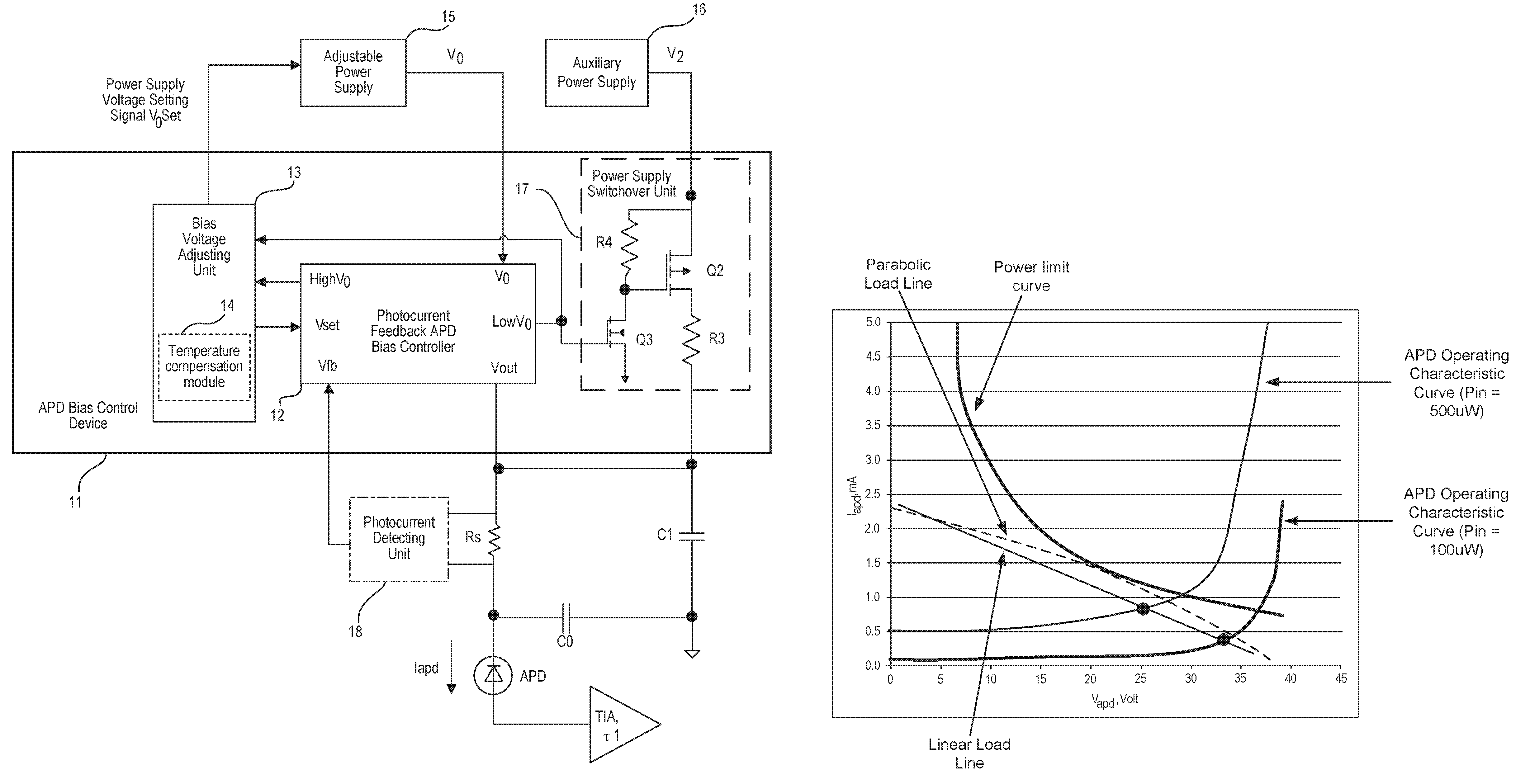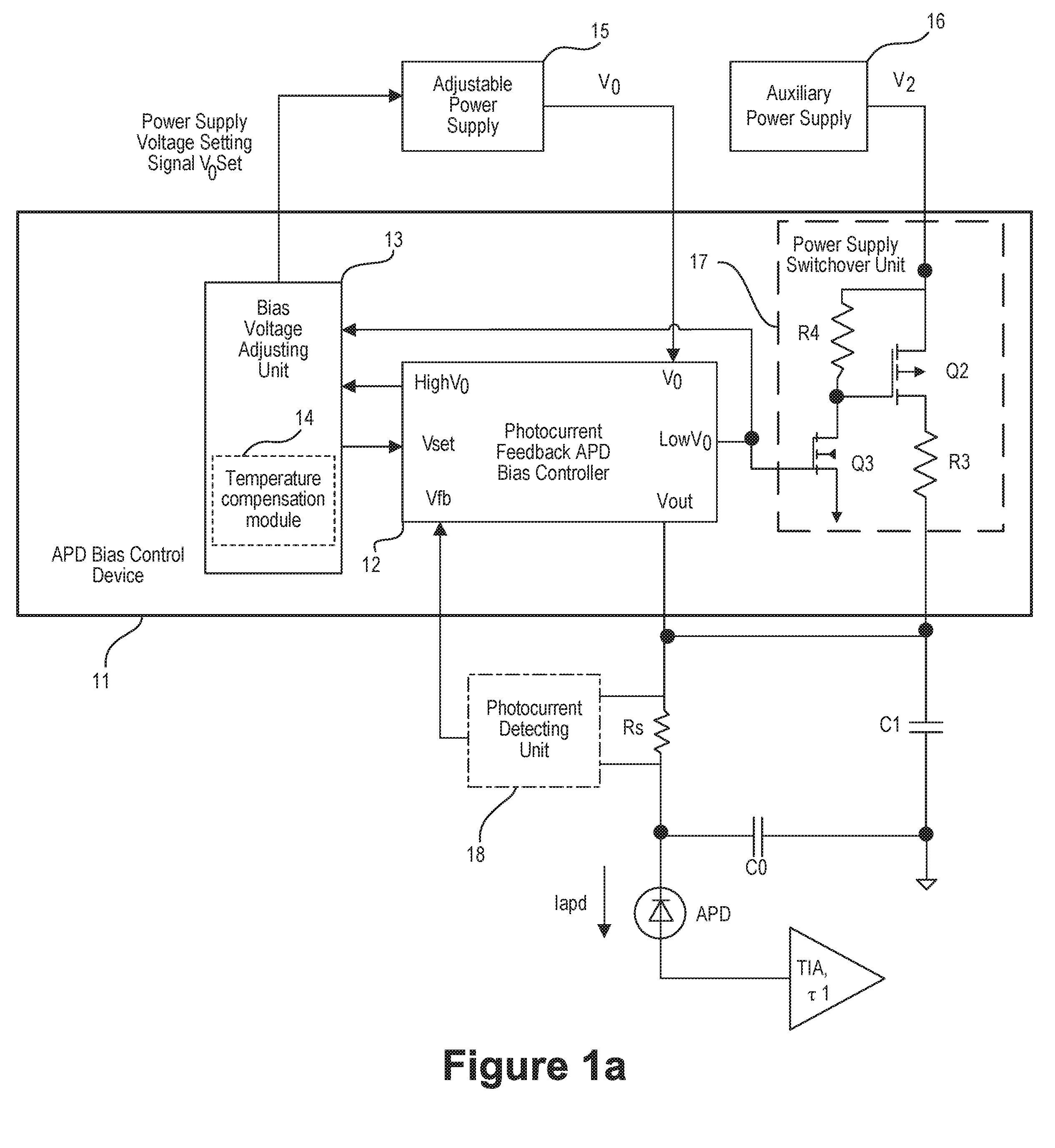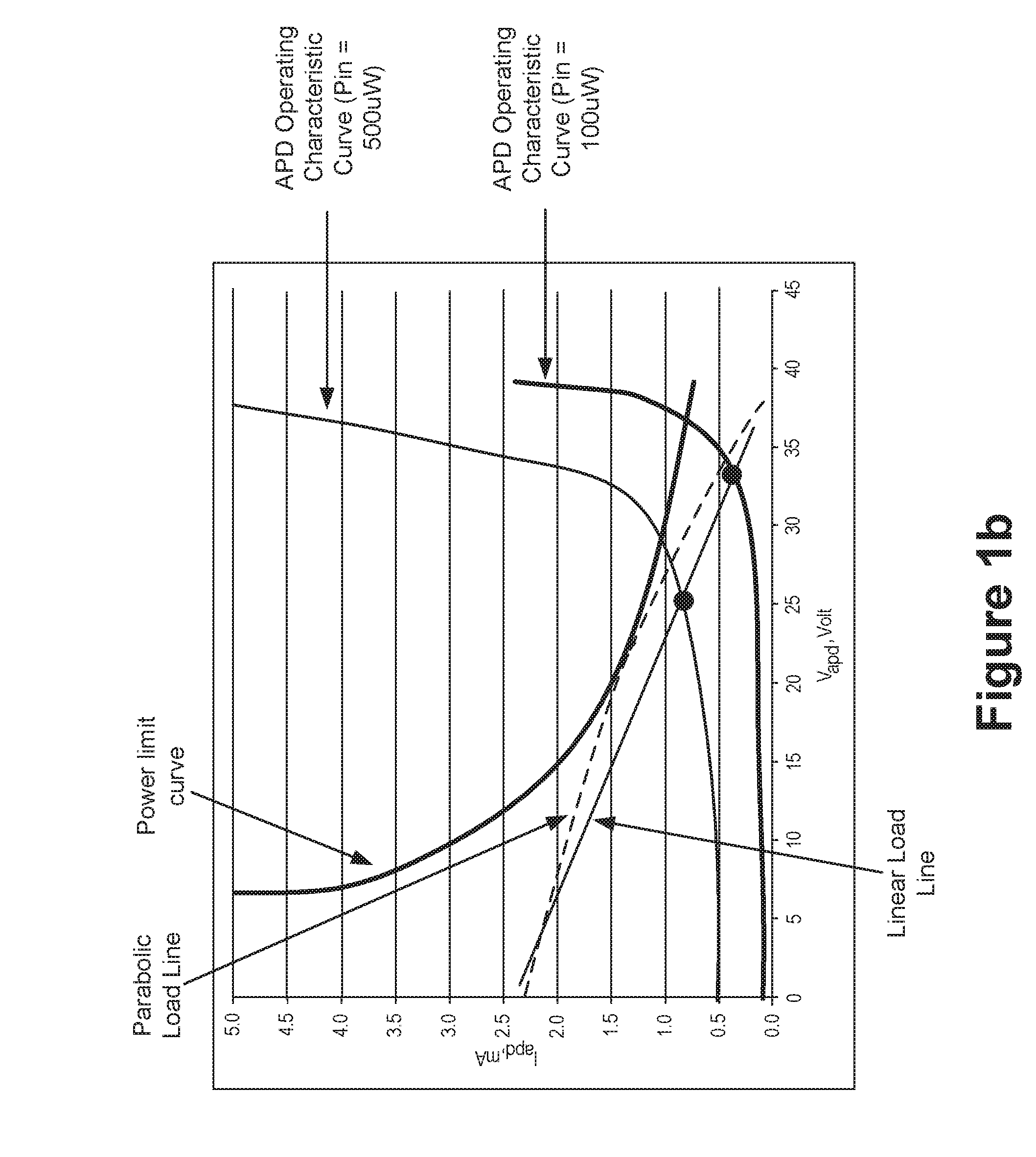Low-power APD bias controller, bias control method, and photoelectric receiver
a low-power, bias controller technology, applied in the field of optical communication, can solve the problems of large power waste, large power consumption, and large power consumption of current-limiting resistors, and achieve the effect of sufficient dynamic response capability, maximum signal-to-noise ratio, and low power consumption
- Summary
- Abstract
- Description
- Claims
- Application Information
AI Technical Summary
Benefits of technology
Problems solved by technology
Method used
Image
Examples
embodiment 1
[0053]Let there be an APD, Vbr=+40V, n=2. Further, let Vin=+0.8V; Vs can be neglected; the gain of the sampling circuit (Rs*Gs) is 0.5 k ohm; and the APD responsiveness η=1 mA / mW. Set V0=+40V, and select a linear function for func(x), i.e.
func(Vf)=32*Vfb+0.5=16e3*Iapd+0.5 (8)
Vapd=40−0.8−Vdrop=38.7−16 k*Iapd (9)
[0054]As shown in FIG. 1b, we can draw the APD load line (a straight line in this case) in an I-V graph according to Formula 9; on the other hand, we can draw the APD operating characteristic curves at optical input powers of 100 uW and 500 uW, respectively, according to Formula 3. In the I-V graph, the voltage and photocurrent at the point of intersection between the APD operating characteristic curve and the load line are the APD's bias voltage and photocurrent at the corresponding input optical power.
[0055]Let the sensitivity level be Pin=3.8 uW, it can be determined that at this point Iapd=40 uA according to the I-V graph, Vdrop=1.14V and Vapd=38.06V according to Formula...
embodiment 2
[0086]Using the same APD characteristic parameters and circuit parameters in Embodiment 1, and let the sensitivity target be 3.8 uW and func(x) be a linear increasing function determined by Formula 5, i.e., func(Vfb)=16 k*Iapd+0.5, and let B=32, Vset0=Vref=+1.25V, A=32, V0set0=V0 / A=1.25V. Further, let Vdrop0=0.82V, Vdrop_min=Vdrop_extreme=0.5V, Vdrop_max=1.14V. Below is a description of the operating mode of the Vdrop control loop when the optical input power increases from the sensitivity point of 3.8 uW (corresponding Iapd=40 uA) to +1.94 mW (corresponding Iapd=2 mA).
[0087]According to calculations in Embodiment 1, when the optical input power is 3.8 uW and Vdrop is not controlled, according to the load line and characteristic curve shown in FIG. 1b, Iapd=40 uA, Vapd=38.06V, Vdrop=1.14V. After the Vdrop control loop is enabled, because Vdrop is greater than its target value 0.82V, the error integrator will increase ΔV gradually in the negative direction until ΔV=(0.82−1.14) / B=−0.3...
embodiment 3
[0119]Let the APD characteristic parameters, circuit parameters, and Vdrop function be the same as in Embodiment 2. Set R3=16 k ohm, according to the calibration steps described before and Formulas 22 and 25, V0set_opt=1.25V, C=0.5V, V2=40−0.5=39.5V. Further, let the stabilization time of the Vdrop control loop be approximately 500 ms, the current optical input power Pin=1.95 mW, Iapd stabilized at 2 mA, Vdrop control loop stabilized, Vdrop=0.82V, V0=8.32V. The table below describes the process of change in the circuit's operating state when the optical power decreases to the sensitivity point Pin=3.8 uW within 10 us.
Table 1:
[0120]
State of loadState of dual-sourceState of controlTimeOptical powerState of APDcircuitpower supplyloop0 1.95 mWIapd = 2 mA,V0 = 8.32 V,State 1,LowV0 = 0,Vapd = 6.8 V,Vdrop = 0.82 VV2 = 39.5 V,ΔV = −0.99,M = 1.029Vapd1 = 7.82 VVset = 0.26,Continues1.918 mWIapd = 1.98 mA,V0 remains theSeamless switchoverLowV0 = 1,Vapd = 7.02 V,same Vdrop =into State 2.2,ΔV, V...
PUM
 Login to View More
Login to View More Abstract
Description
Claims
Application Information
 Login to View More
Login to View More - R&D
- Intellectual Property
- Life Sciences
- Materials
- Tech Scout
- Unparalleled Data Quality
- Higher Quality Content
- 60% Fewer Hallucinations
Browse by: Latest US Patents, China's latest patents, Technical Efficacy Thesaurus, Application Domain, Technology Topic, Popular Technical Reports.
© 2025 PatSnap. All rights reserved.Legal|Privacy policy|Modern Slavery Act Transparency Statement|Sitemap|About US| Contact US: help@patsnap.com



